
By BitterGrey
Adam Smith, arguably the father of modern economics, made an elegant observation. Per the preoccupation of economists of his day, it focused on widgets. (What exactly is a widget, anyway?)

This is
great for widget manufacturers, but what if you are
trying to decide whether or not to wear diapers 24/7? Let's
explore that.
Does the value of wearing a diaper decrease as more time is spent
in diapers? Yes, sorta. For discussion's sake, let's consider the value per additional hour. If you only spend a few hours per
week in a diaper, they are probably at times when you could most enjoy the
diaper. An infantilist might spend it relaxing with
stuffies. A diaper fetishist might spend it playing with a
lover. In contrast, if you spent all week in diapers, it would
involve times when you couldn't enjoy the diaper. For
example, an hour might be spent getting yelled at by your boss.
You can read more about the benefits in pros, cons, and options of being in diapers. So
yes, the value of an hour spent in diapers decreases with increasing quantity, sorta.
Does the cost of wearing a diaper increase as more time is spent
in diapers? Yes, sorta. First off, the risk of leaks
changes. To avoid
leaks in front of the boss, you would need to wear more absorbent
(more expensive) diapers and/or change more often. Either will also increase the environmental costs.
Second, we should consider non-monetary costs: Carrying around changes of
diaper and possibly pants, etc. Third, you might avoid
activities because of diapers. For example, if you want to go for a swim but
decide not to because of diapers, then that missed opportunity would be a cost too (an opportunity cost). You can read more about the costs in pros, cons, and options of being in diapers. So yes, the cost of an hour spent in diapers increases, sorta.
Do these two necessarily balance at some point? This is where Daddy Econ would shake his finger at me. The buyers would be actively selecting sellers based on price. In turn, the sellers would be producing or not, based on price. In Daddy Econ's original model, they could sort themselves independently. In contrast, an ABDL getting the enjoyment from his 20th hour per week in diapers would be stuck paying the cost of the 20th hour. As a result, the curves might cross more than once. This forces a two-part solution. (This isn't a surprise, since changing diapers takes two hands anyway.)
The first part of the solution is the same as for Daddy Econ's widgets. If the benefit you'd get from wearing diapers an extra hour each week is greater than the costs of wearing that extra hour, wear more. However, if the benefit is less than the costs, wear less. This will move you toward a point where you'll want to wear more, but that want will be balanced by the costs of wearing more. (Yes, that's right. Daddy Econ says you should want to wear diapers more.)
The second part of the solution is new, although its derivation isn't difficult: Try different levels when and if the opportunity arises. The first part will guide you to a point of balance, but maybe not the best one. Since hours can't sort themselves, there might be many points where the curves cross. For example, possibly the most costly region for ABDLs is attempting to wear diapers very rarely, where the binge-and-purge cycle occurs. Since the costs outweigh the benefits in this region, the first hand will move the ABDL towards trying to not wear, perpetuating the binge-purge cycle.
The second part of the solution is to jump to different levels. For your particular values and costs, the best level might be never wearing diapers, wearing monthly, wearing weekly, wearing nightly, wearing most of the time, wearing 24/7, or somewhere in between. Jumping from trying not to wear at all (and binging) to wearing monthly will get you away from the binge-and-purge costs, but then the costs associated with a shy bladder might be a problem. Jumping to wearing weekly might avoid the shy bladder costs by keeping it diaper-trained, but would add other costs, such as displacing other weekend activities that aren't diaper-compatible. Each level has its associated benefits and costs. However, trying out the new level will involve lifestyle changes, adjustments to the layette, and some time for the newness to wear off. Getting an accurate sense of the costs and benefits of enjoy each level might take months. In practice, you'll probably need to act on estimates, wait for opportunities, and probably leave levels untried.
Daddy Econ's model assumes people would thoughtfully act in their own best interest. You need to do this too. Be aware that at the optimal level for you, you'll want to wear more. Be aware that the novelty that any new level offers will wear off. Be aware that untried levels might seem more attractive, since fantasies focus on the benefits, not the costs. Given all this, there is a best level for you. Find it.
Do you have Questions, tips, suggestions, or other feedback?
|